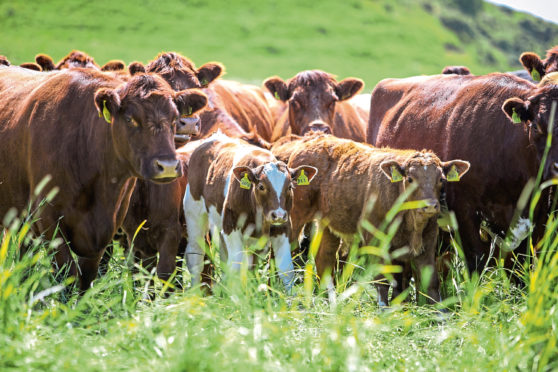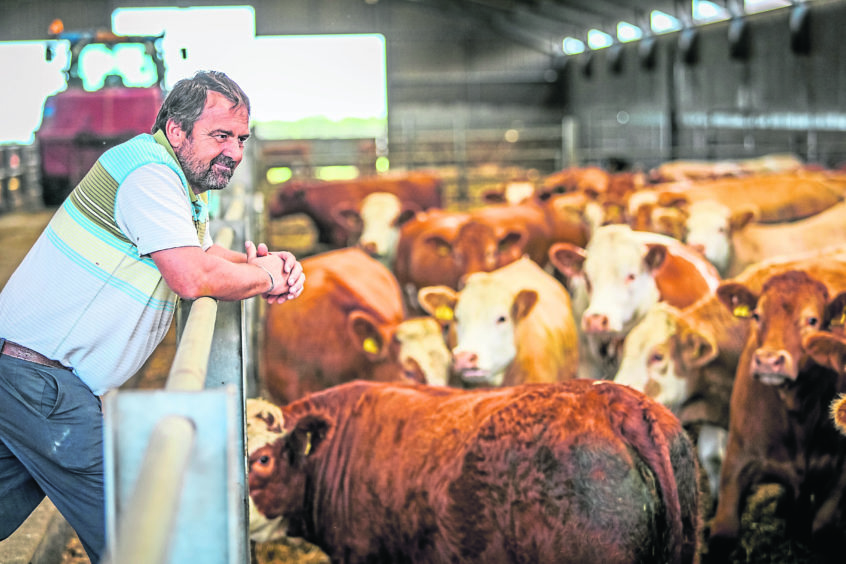The image of Luing cattle is entwined with the challenging land of their Hebridean heritage, but breed enthusiasts visiting Fife next week will find evidence they are just as suited to the gentler climes of the East Neuk.
Hundreds of breeders and commercial farmers on their annual Luing Society outing will descend on one of the country’s biggest herds at Balcaskie, an estate which covers a 5,800-acre strip of south-east-facing land, from a 350ft high point at Lochty Farm down to the coast at Anstruther.
Balcaskie’s farm manager, Dave Nicol, will lead a convoy of up to 12 tractor-trailer loads of people on a tour of the estate’s lush grassland where they’ll see a field of 85 bulling heifers, a herd of 39 pure Luing running with a Luing bull, a mob-grazing group of 70 pedigree animals with an Angus bull and hundreds of commercial Sim-Luing cows and their calves.
Dave has worked with Luings for most of his career and was manager at Lochty Farm for more than 20 years before it was bought by Balcaskie in 2007.
His previous job included managing the same breed in harsh winters in Glen Finglas in the Trossachs and he can’t see past the hardy milky cows.
“They do well, whether it is on the hill or rough grazing or good quality grassland, and they’re easily kept,” he said.
“They are happiest outside all winter and in Glen Finglas they stood outside in an open glen.
“If we had 300 acres of hill land here they’d never come indoors.
“They are easy to handle and rarely need help with calving. Of the 120 pedigree Luings, we’d be surprised if there were two that needed help.”
It is the risk of poaching the land that means Balcaskie’s herd is housed for a short time over the winter, but changes to the estate’s farming policy could open up space to outwinter the herd in future.
Balcaskie’s philosophy is to farm as naturally as possible and around 700 hectares of grassland have been classified as organic in the last few years. Eventually the whole estate will be converted to organic production and the ultimate aim is to finish all stock on a forage-only diet.
“We’re trying Pasture for Life, which means using no cereals, so we will probably be finishing calves at 26 to 27 months in future rather than the current 20 to 22 months,” said Dave.
“Most of the land is now in grass to build fertility in the soils, so for the next five years we’ll probably struggle to utilise it all.
“It means we’ll be increasing the ewe flock and building the cattle herd to 550-600 head and eventually all the cattle will be mob grazed.”
The benefits of the organic label are already being seen, with the most recent batch of finished cattle, which went to Scotbeef at Inverurie, earning a significant premium price of 440ppk for R4Ls.
Until recently Balcaskie’s commercial herd has comprised only Sim-Luings but the estate has started to experiment with crossing the pedigree Luings with native breeds like Aberdeen-Angus and Red Lincoln to capitalise on what they see as a growing market.
Breed chairman Mark Thomson, from Tillyrie at Milnathort, will also be on hand to welcome the visitors from across the UK and Ireland.
He points to the success the breed has had in a relatively short space of time.
“In the last five years alone the number of registered breeding females has doubled to just short of 11,000,” he said.
“It’s still a young, up-and-coming breed.
“Don’t forget it didn’t achieve breed status until an Act of Parliament in 1966.”
Mark, who has 90 Luing cows and heifers, half of which are kept pure and half crossed with the Simmental, believes the breed’s popularity will continue to grow.
“We’ve focused for a long time on maternal side, now we need to look at the breed’s meat capacity,” he said.
The proof, of course, is in the eating and next week’s lunch of Balcaskie’s Luing beef burgers is likely to sway any visitors who still need to be convinced.

